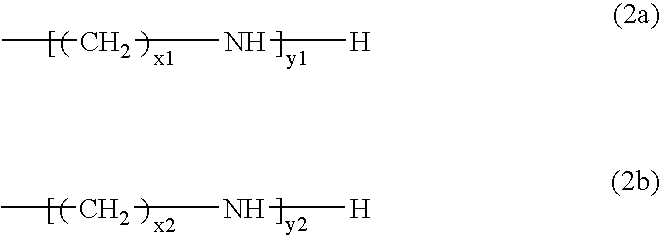Non-specific adsorption inhibitor, probe-bonded particles, and method for producing the same
a technology probe-bonded particles, which is applied in the field of non-specific adsorption inhibitors, can solve the problems of noise increase, insufficient sensitivity, interference with sensitivity promotion, etc., and achieve the effect of sufficient noise reduction and easy production
- Summary
- Abstract
- Description
- Claims
- Application Information
AI Technical Summary
Benefits of technology
Problems solved by technology
Method used
Image
Examples
example 1
2.1. Example 1
[0054]A separable flask equipped with a stirrer was charged with a solution of 10 g of a polyoxyethylene monomethyl ether having an average molecular weight of 4,000 (“Uniox M-4000” manufactured by NOF Corp.) dissolved in 100 g of pyridine. In another container, 2 g of p-toluenesulfonyl chloride was dissolved in 20 g of pyridine. This solution was added dropwide to the solution in the separable flask over one hour and reacted at room temperature for six hours. The reaction product was added dropwise to one liter of diethyl ether to precipitate and remove the remaining p-toluenesulfonic acid chloride. 8 g of a tosylated compound of the polyoxyethylene monomethyl ether (A-1) was thus obtained.
[0055]80 g of an aqueous solution containing 8 g of the tosylated compound (A-1) was added dropwise to 50 g of an aqueous solution containing 2 g of pentaethylenehexamine (B-1) while stirring at room temperature over two hours to react (A-1) with (B-1). The reaction product was adde...
example 2
2.6. Example 2
[0064]A separable flask equipped with a stirrer was charged with a solution of 100 g of polyoxyethylene monomethyl ether having an average molecular weight of 5,000 (manufactured by Fluka), 5 g of trimethylamine hydrochloride, 8 g of tripropylamine, and 8 g of p-toluenesulfonyl chloride dissolved in 300 g of acetonitrile. The solution was reacted at 30° C. for two hours while stirring to obtain a tosylated compound of the polyoxyethylene monomethyl ether (A-2).
[0065]Another separable flask equipped with a stirrer was charged with a solution of 47 g of pentaethylenehexamine (B-2) dissolved in 230 g of acetonitrile. The tosylated compound (A-2) was added dropwide to the solution while stirring and keeping the solution at 40° C. over one hour. The mixture was reacted by further stirring for nine hours. After the reaction, the solution was allowed to stand for 16 hours at room temperature and the precipitated byproduct was removed by decantation. The supernatant liquid obt...
PUM
| Property | Measurement | Unit |
|---|---|---|
| temperature | aaaaa | aaaaa |
| concentration | aaaaa | aaaaa |
| adsorption | aaaaa | aaaaa |
Abstract
Description
Claims
Application Information
 Login to View More
Login to View More - R&D
- Intellectual Property
- Life Sciences
- Materials
- Tech Scout
- Unparalleled Data Quality
- Higher Quality Content
- 60% Fewer Hallucinations
Browse by: Latest US Patents, China's latest patents, Technical Efficacy Thesaurus, Application Domain, Technology Topic, Popular Technical Reports.
© 2025 PatSnap. All rights reserved.Legal|Privacy policy|Modern Slavery Act Transparency Statement|Sitemap|About US| Contact US: help@patsnap.com



